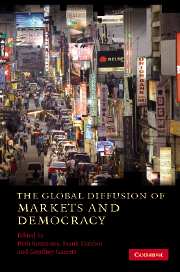Book contents
- Frontmatter
- Contents
- List of appendixes
- List of figures
- List of tables
- Notes on contributors
- Acknowledgements
- 1 Introduction: the diffusion of liberalization
- 2 Tax policy in an era of internationalization: an assessment of a conditional diffusion model of the spread of neoliberalism
- 3 The decision to privatize: economists and the construction of ideas and policies
- 4 The international diffusion of public sector downsizing: network emulation and theory-driven learning
- 5 Global ideology and voter sentiment as determinants of international financial liberalization
- 6 Competing for capital: the diffusion of bilateral investment treaties, 1960–2000
- 7 Diffusion and the spread of democratic institutions
- 8 World society and human rights: an event history analysis of the Convention on the Elimination of All Forms of Discrimination against Women
- 9 Conclusion
- Index
- References
1 - Introduction: the diffusion of liberalization
Published online by Cambridge University Press: 04 August 2010
- Frontmatter
- Contents
- List of appendixes
- List of figures
- List of tables
- Notes on contributors
- Acknowledgements
- 1 Introduction: the diffusion of liberalization
- 2 Tax policy in an era of internationalization: an assessment of a conditional diffusion model of the spread of neoliberalism
- 3 The decision to privatize: economists and the construction of ideas and policies
- 4 The international diffusion of public sector downsizing: network emulation and theory-driven learning
- 5 Global ideology and voter sentiment as determinants of international financial liberalization
- 6 Competing for capital: the diffusion of bilateral investment treaties, 1960–2000
- 7 Diffusion and the spread of democratic institutions
- 8 World society and human rights: an event history analysis of the Convention on the Elimination of All Forms of Discrimination against Women
- 9 Conclusion
- Index
- References
Summary
The worldwide spread of economic and political liberalism was one of the defining features of the late twentieth century. Free-market oriented economic reforms – macroeconomic stabilization, liberalization of foreign economic policies, privatization, and deregulation – took root in many parts of the world. At more or less the same time, a “third wave” of democratization and liberal constitutionalism washed over much of the globe. Most economists believe the gains to developing countries from the liberalization of economic policies to be in the hundreds of billions of dollars. But they also acknowledge the instability and human insecurity sometimes left in liberalization's wake. Political scientists argue that the rise of democracy has contributed to the betterment of both human rights and international security. While the precise effects of these twin waves of liberalization are still debated, it is hard to deny that they have had a tremendous impact on the contemporary world. This book examines the forces that help account for the spread of political and economic liberalization. Why has much of the world come to accept markets and democracy?
Some commentators focus on the exercise of American power. According to this line of argument, the hegemonic United States – often acting through the Bretton Woods international economic institutions it helped create after the Second World War – has used a combination of carrots (political and military support as well as preferential access to American markets) and sticks (from strings attached to financial assistance to threats of military coercion) to impose its vision for political and economic liberalism on the rest of the world.
- Type
- Chapter
- Information
- The Global Diffusion of Markets and Democracy , pp. 1 - 63Publisher: Cambridge University PressPrint publication year: 2008
References
- 56
- Cited by



